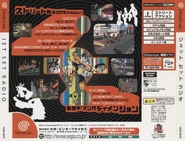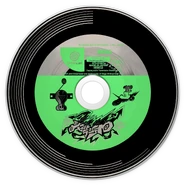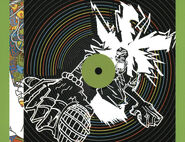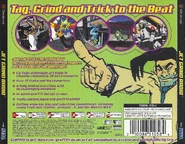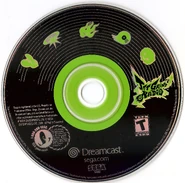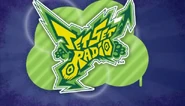- "Tag, Grind and Trick to the Beat!"
- —Tagline
Jet Set Radio (ジェット セット ラジオ Jetto Setto Rajio?), known as Jet Grind Radio in NTSC areas, is a video game developed by Smilebit and published by Sega, released on June 29, 2000. Jet Set Radio was designed for the Dreamcast, although a version of the game was later released for the Game Boy Advance with the same name.
Twelve years later the game would be remastered and ported to most relevant consoles at the time.
Plot[]
Prologue[]
The game starts off with a prologue, narrated by DJ Professor K, the host of a pirate radio station based in Tokyo-to, who explains the hottest things in Tokyo's streets being the punks who wear newly developed magnetically driven in-line skates, and Jet Set Radio, the pirate radio station ran by him, the station plays nothing but non-stop hardcore music. DJ K reveals that the street punks have been named "Rudies", by the people of Tokyo-to, as they roam the streets and cover the city with their personal graffiti expressing themselves in the world. Despite this, the Metropolitan Government and a financial conglomerate known as the Rokkaku Group, combined their efforts to find the "21st Century Project" to stop the street punks, as police crackdowns have gotten more extreme as of lately. DJ Professor K states: "The streets of Tokyo-to are ready to explode..."
Chapter 1[]
After the prologue is completed, the game starts in Shibuya-cho, where a character named Beat is trying to recruit others for his gang, the GG's. After completing both Gum and Corn's tutorials, the GG's are formed with Shibuya-cho being their home turf. Once that is over with, the first broadcast of the game happens with DJ Professor K giving a rundown on what is happening on the Tokyo streets. Three gangs are fighting over it with the first being the Noise Tanks of Benten-cho, located in the west, then Poison Jam from the east in Kogane-cho, and finally from the south in Shibuya-cho, the GG's. Professor K reveals that the GG's home turf was attacked and questions if either Poison Jam or the Noise Tanks did it. He warns that the police and their captain, Onishima, is ready to arrest them.
After completing the first mission, it is revealed that a new gang called the Love Shockers were the ones who went after the GG's home turf. The GG's instantly take after the Love Shockers' graffiti, and are close to claiming their turf back, however, they also go after Benten-cho and Kogane-cho in the process. Depending on which route the player takes, Poison Jam will either send frogs to the GG's hideout, the garage, or the Noise Tanks will kidnap the GG's dog, Pots. Eventually the frogs will leave and the GG's will rescue Pots. During the defeat of their rival gangs, the Noise Tanks will drop a piece of an unspecified vinyl record, along with Poison Jam, who gets kidnapped in the process. When the Love Shockers are finally taken down, a fallen member of the gang reveals that she was holding a Golden Rhino badge. DJ Professor K reveals that the Golden Rhinos are a gang of ruthless Asian killers, and states that there are rumors about them being the ones that kidnapped Poison Jam. He also details on who Goji Rokkaku is and what his "Rokkaku Project 2000" is supposed be as it is the "future" of Tokyo, with DJ K disregarding it.
During this chapter, the player as the opportunity to unlock three characters, Garam, Mew, and Yo-Yo.
Chapter 2[]
At the start of chapter 2, two skaters named Combo and Cube stop by the garage, requesting assistance from the GG's. The gang agrees to help them if they can replicate their challenge and win a race against them, to which both Combo and Cube succeed at. Beat requests Combo to tell him what is really going on to which Combo details events from two months ago, revealing that his, Cube, and Coin's home turf, Grind City, was overtaken by strange looking graffiti over their own tags. He quickly details Coins kidnapping and that his record collection was destroyed as well. Combo also notes the arrival of the Golden Rhinos, stating that it looks like as if they are waiting for someone. Due to the oddities happening in Bantam Street and Grind Square, Combo assumes something fishy is going on.
After taking back Bantam Street from the Golden Rhinos, Combo and Cube come across a message from Coin telling them to head to Grind Square. Combo figures out that the Golden Rhinos are most likely at Grind Square too and assumes that they knew about them covering up their graffiti. Once Combo and Cube finish claiming Grind Square, it is revealed that the district was built by the Rokkaku Group, and Combo wonders if the men in black suits are connected to the organization. Combo and Cube find another message from Coin that they do not understand as he painted a golden rhino, mentions Jet Set Radio, and tells them to head to Tokyo. The duo realizes they have no other choice but to make their way to Tokyo and to find the GG's, leading them to the current events.
Chapter 3[]
In chapter 3, DJ Professor K reveals that the Golden Rhinos are a secret branch of the Rokkaku Group and how the gang is going after anyone who remains on the streets. Once a second Golden Rhinos mission is completed, DJ Professor K, thanks to an informant, reveals that the thing that everyone is hunting for is a record called the "Devil's Contract", which has the power to summon a demon. Professor K notes how Tokyo-to is in a state panic and questions if the GG's graffiti can save the city. The GG's eventually cover up all of the Golden Rhinos and Rokkaku posters in each district, but someone managed to swipe the Devil's Contract from them.
In another broadcast, DJ Professor K reveals that the "Devil's Contract" went missing, and after defeating Poison Jam again, the GG's received some info from the rival gang, who detail what Goji's big plans are. Goji wants to use the record to make a contract with a demon so he can take over Tokyo and eventually the world. DJ Professor K urges the GG's to head to the Rokkaku Headquarters so they can destroy the "Devil's Contract" and Goji's plans.
In this chapter, the player can also unlock Piranha and Slate.
Epilogue[]
The GG's eventually defeat Goji, who falls to his doom, failing to take over Tokyo and the world. During the epilogue it is revealed that the Rokkaku Group made a cover up story of why the building was destroyed, with Goji's son taking over operations of his family's business. Tokyo is now back to normal. Once again, the Golden Rhinos are mentioned to be another group of Goji's henchmen, but despite all of this it does not end well as Coin's life was costed due to Goji's obsession with control.
The "Devil's Contract" is also revealed as a hoax, and nothing more but an old indie record that Goji might have made up with his own mind. The rival gangs are also mentioned as the Noise Tanks were in repair, the Love Shockers were once again broken-hearted, and that Poison Jam was back and already planning mischief once again. It is also noted that the three rival gangs were not too different from each other as all of them were trying to make sense of their own lives as well.
The game ends with DJ Professor K seemingly responding to someone doubting his story, claiming that he made it up. He plays into the idea of it and states that someone might have their sights on Shibuya-cho again, and claims that "On the street, there's no such thing as 'The End!'"
Gameplay[]
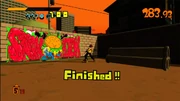
Beat completing a extra-large graffiti piece in Kogane-cho.
The gameplay of Jet Set Radio is very arcade-like, as missions have a timer during them, with the max being 999 seconds. When tagging, players must do inputs to successfully complete large or extra-large graffiti tags. When it comes to collecting graffiti most characters can hold a range between 7 to 50 spray cans, with the exception of Pots, who can only hold seven cans. Small tags only use one can and are completed automatically, while large tags take up to three cans, and extra-large uses seven. Enemies like Onishima, attack helicopters, and Golden Rhino assassin leaders can be stunned or taken down with graffiti if the player tags their back or windshields. More graffiti can be unlocked by collecting Graffiti Souls, which are present throughout every mission and side mission in the game.
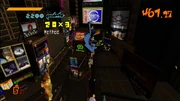
Tab performing an air trick at Grind Square.
Tricks in the game are also performed automatically while grinding not requiring an input from the player unless they do a turn-around trick on rails or during a wallride. Dashing also lasts a few seconds, giving the player a short burst of speed, to which they can avoid getting shot at in the process while the police chase them down. Jumping is also a good way to gain speed in the game. Structures such as halfpipes also appear in some levels.
Players can also hold onto the back of cars. This ability is only present in Shibuya-cho, Benten-cho, and Bantam Street, as all three areas contain moving vehicles.
Development[]
Jet Set Radio was developed by Smilebit, which at the time was a team of less than 25 people, additionally most people on the team were just under the age of 25 as well. The game was formally announced at the 1999 Tokyo Game Show (TGS) and garnered attention due to its unique cel-shaded art style. Before Jet Set Radio started development, at one point Ryuta Ueda showed Masayoshi Kikuchi drawings of characters that would resemble the end-look of the game and said "Let’s do this, let’s do something like this." This lead into creation of the atmosphere for the game.
One of the inspirations for Jet Set Radio was the Sony PlayStation game, PaRappa the Rapper, as Ueda recalled his experience at the 1996 Tokyo Game Show with "When I saw PaRappa The Rapper at TGS… I think that’s the first game with pop culture like that. They did it first. After that I decided to make a true game, not just a visual experience, that was actually for adults."[1]
When it came to the game's graphical style, Kikuchi would mention that he did not initially think of cel-shading instantly, but rather how he could express Ueda's art in the game, and was confident that cel-shading was the best approach. This would eventually lead into Ueda and another designer consulting each other, trying to achieve this style and succeeding. This graphical design was done because games at the time were becoming more realistic and Ueda wanted to do the opposite. When asked if Sega had any requests for a realistic design instead, Ueda would confirm that there was none and mentioned that it was the same with Space Channel 5 and Roommania #203. Kikuchi would also mention that during the early stages of the game's development the team did not have any of the tools that allowed them to achieve the "Manga Dimension" look, as such characters were made without outlines and sharp shading until the middle of development.[2]
During the development of the game the team wanted to combine several ideas, which ranged from Ueda's art, graffiti, street and pop culture, elements from the movie Fight Club such as anti-establishment, and an open world. However, this was not all thought out instantly as Jet Set Radio would have trouble getting past the planning phase, and due to a lack of programmers it allowed Kikuchi to think about the game's story for a year.[3] Some other challenges include incorporating the open world in the game as the control would become hard to handle, to compensate this, the team added the ability to rail grind so people could enjoy the high-speed thrills but could still be aware of their surroundings in the level when getting off of them.[4] Although Jet Set Radio was developed around the time of extreme sports games being at their peak, they did not serve as an influence for the game.[5] However, Kikuchi would reveal in a 2024 interview that the Nintendo exclusive, 1080° Snowboarding, served as an influence for the game. Other Nintendo games that served as an influence were Super Mario 64 and The Legend of Zelda: Ocarina of Time. Ueda would also mention that many aspects of the game were reflections of the team's exciting experiences and dreams.[2] Eventually the team would complete Jet Set Radio and the game would be released in Japan on June 29 2000, just after 10 months of development.[6]
Just after the release of the game in Japan, Jet Set Radio would undergo localization changes to appeal to international audiences. Sega, seemingly worried that the Japan-only focus of the game would alienate their audiences outside the team's home country, would request for additional levels based on New York City, Bantam Street and Grind Square, and the game's name would be changed to Jet Grind Radio in NTSC regions, which was done due to legal reasons as a trademark in the United States was similar to the "Jet Set Radio" name, and was done to appeal to customers in the United States. Thanks to this change, Ueda was asked by fans on why the game's name was not the same while at E3. Despite the addition of the stages, the team realized it would have been "uncomfortable" to just have them in the game with no purpose, which prompted them to add in more elements to the game's story. To capture the accuracy of NYC, designers from Smilebit went to the areas in the city and conducted interviews while visiting.[2]
These changes also allowed Sega to re-release the game under the name De La Jet Set Radio as well. However, some people a part of Smilebit were not terribly fond of it as Ueda himself felt like his pride was hurt and believed the Japanese elements of the game would be watered down, but would come to accept these changes as his creative side won over.[7][8] Ueda would also reveal that the request of adding in American stages from Takayuki Kawagoe to the international release of the game felt like a "bolt out of the blue".[2]
Jet Set Radio would release internationally on October 31, 2000 in North America/NTSC regions and would release on November 24, 2000 in Europe/PAL regions. This version of the game contained additional content not present in the original Japanese release such as a second chapter for the story, music, and additional playable characters. However, Japan would later receive the updated version of Jet Set Radio via De La Jet Set Radio almost a year later.
Promotion[]
To promote Jet Set Radio in the United States, Sega would hold an 11-minute dance show during E3 2000. Additionally, another dance show would be held in Japan under the name of "Ikasuze! Jet Set Radio". Sega would also hold two graffiti contests, one being called Graffiti is Art, with the prize being $5000 USD, and another in collaboration with the graffiti website, TagMag, were up to five people could win a free copy of the game.[9] Sega would hold another graffiti contest for the HD release of the game.
Soundtrack[]
- For the game's soundtrack click here: Jet Set Radio Soundtrack.
The soundtrack for Jet Set Radio contains a diverse lineup of musical talent and genres, mainly ranging from electronic, hip-hop, and rock, with influences from other genres like funk, coming into play. The game's main composer is Hideki Naganuma, who would make several original songs for the game and also pick some of the licensed music as well. Additional artists include fellow Sega in-house composers, Richard Jacques and Toronto. The original Japanese release only had licensed music from Japanese artists, Guitar Vader, Deavid Soul, and Idol Taxi, all three would be present in every other release of the game along with external artists who made original songs for the game such as the Reps, F-Fields, Castle Logical with Yoshika Sekine, and B.B. Rights.
When discussing the game's soundtrack it was revealed that there were no "orders" from the development team on how to make it. Kikuchi would mention how Naganuma looked at the game drawings and other specifications to create sound for the game. Ueda would bring up how Naganuma liked funk music and artists such as Prince and Sly and the Family Stone. Ueda would also mention that due to the revival of DJ culture via the Big Beat genre it allowed Naganuma's mixing style to match with the game's atmosphere. On the topic of licensed artists, the sound team took initiative on who fit the game's "image" the best. Some artists such as Guitar Vader, were direct acquaintances of the sound team.[2]
To appeal to international audiences, Sega would request additional levels inspired by New York City, and as such more artists were added to the game. A total of eight would be added but neither NTSC or PAL regions would receive all eight. The artists NTSC audiences would get would be Rob Zombie, being remixed by Charlie Clouser, Cold, and Professional Murder Music, while PAL audiences got music by Featurecast, O.B. One, and Semi Detached. Both regions would get songs by the Jurassic 5 and Mix Master Mike, with Japan later on getting the PAL region artists along with the two aforementioned ones in De La Jet Set Radio.
The HD release of the game attempted to give everyone all the musical talent that contributed, but failed to get O.B. One back for the game, making them the only omitted artist.
Jet Set Radio would have its soundtrack be released in Japan in December 20, 2000. Customers in the United States who pre-ordered the game would receive a music sampler, containing four additional songs not present in any release. A second soundtrack release would happen in 2012, released by Sumthing Else Works to promote the HD release of the game, as it only featured the Sega in-house songs along with Naganuma's seven original songs from Jet Set Radio Future. There would also be another soundtrack release for the HD release of the game, once again only featuring the in-house songs from Sega along with the graffiti spray sound effects.
Re-releases and other versions[]
De La Jet Set Radio[]
- Main article: De La Jet Set Radio
2001 Japan-only reissue of the game featuring content from the localized versions.
Jet Set Radio (GBA)[]
- Main article: Jet Set Radio (GBA)
In 2003 for North America, and 2004 for Europe, Jet Set Radio would receive a demake for the Game Boy Advance. Adapting the console game with handheld limitations in mind. It would receive positive reviews.
Jet Set Radio HD[]
Jet Set Radio receiving a high-definition release was initially teased by Masayoshi Kikuchi and Ryuta Ueda in 2011.[10] Just a year later, developed by BlitWorks, there was a re-release of Jet Set Radio released on PSN, Xbox Live, and PC in full HD. Additional ports for iOS, Android, and Vita were also released at different times. The game was released September 19th, 2012, by Sega. In addition to upscaled graphics, three tracks were removed ("Yappie Feet" by Deavid Soul from the original NTSC/PAL and De La releases, "Many Styles" by O.B. One from the PAL version/De La release, and "Dunny Boy Williamson Show" by Deavid Soul from the original Japanese version; although Sega accidentally confirmed the last song to be returning on their blog[11]), achievements were added, and a bonus section was implemented, which contains a documentary of the game's development titled "Jet Set Radio Documentary: The Rude Awakening" and unlockable music from Jet Set Radio Future. To save space, the documentary is not available on the mobile editions. Japanese audiences would not get the HD release until 2013, minus consumers who had an iOS product, who received it in 2012 along with everyone else. In 2014, the iOS and Android versions were pulled from both the App Store and Google Play store due to incompatibility with higher mobile OS.[12]
Additionally, players could play the HD release of Jet Set Radio on the Xbox One and Series X/S systems if they purchased the game on their Xbox 360. However, the game is not available for purchase on either of the following consoles. Jet Set Radio would be one of the many games to get delisted from the Xbox 360 marketplace as well.[13]
Reception[]
Dreamcast[]
The game was received exceedingly well from online sources and magazines. Many have praised the style of the game as the matching soundtrack with up-tempo music. Critics also applauded the simplistic "pick-up and play" arcade style gameplay. The lowest review according to Game Rankings was a 3.5 out of 5 from Independent Gamer. IGN gave the game a 9.6/10 rating but criticized the camera control, saying, "You'll spend at least a week wondering why all games don't look this good. Then you will spend at least a month wondering why the camera didn't get fixed during localization."[14] The lack of multiplayer was also criticized.
HD release[]
For the HD release, Jet Set Radio got more mixed reviews, in similar vein to most Dreamcast re-releases, ports, or remasters. While people still praised the game calling it fun, and celebrated certain aspects like the soundtrack and presentation, critics would criticize the gameplay by saying it was outdated and frustrating.[15] The mobile ports of the game were also criticized for not being able to keep up with what the player was required to do.[16]
Awards and accolades[]
Jet Set Radio has received multiple awards for "best console game". It also got an award for its music and cel-shaded art. At the E3 Game Critic Awards, Jet Set Radio won the "Best Console Game" category.[17] The game also won GameSpot's "Best Graphics, Artistic" award as well.[18] Jet Set Radio also received many other accolades for things such as its music, game and sound design, and visual engineering.[19] The game would also be included in the book, 1001 Video Games You Must Play Before You Die, as one of the eight Dreamcast games featured in it.
In 2009, the major antagonist of the game, Captain Onishima, was ranked 95th in IGN's "Top 100 Video Game Villains" list.[20]
Credits[]
- Click here to see the credits for Jet Set Radio: Jet Set Radio/Credits.
Gallery[]
- For more images relating to Jet Set Radio see: Jet Set Radio/Gallery.
Achievements[]
- For the achievements in the HD release of the game see: Jet Set Radio/Achievements.
Beta elements[]
- Click here to read about some of the unused or removed content from the game: Jet Set Radio/Beta elements.
Trivia[]
- For trivia relating to the game, please checkout: Jet Set Radio/Trivia.
References[]
- ↑ Behind the Scenes: Jet Set Radio, page 1. GamesTM (January 7, 2011). Retrieved on August 6, 2023.
- ↑ 2.0 2.1 2.2 2.3 2.4 Inamoto, Tetsuya, Wataru Nagayama (March 25, 2024) [インタビュー]“ショウワ99年”記念! 「ジェットセットラジオ」開発陣がシリーズ誕生秘話と完全新作への意気込みを語る. 4Gamer.net. Retrieved on March 26, 2024.
- ↑ Lehecka, Eddie (June 23, 2020) Masayoshi Kikuchi Interview. Otaquest. Retrieved on August 6, 2023.
- ↑ Behind the Scenes: Jet Set Radio, page 2. GamesTM (January 7, 2011). Retrieved on August 6, 2023.
- ↑ McCarthy, Caty (June 29, 2020) 20 Years Later, The Rowdy Creators of Tokyo-to Reflect on Making Jet Set Radio. VG247. Retrieved on August 7, 2023.
- ↑ SEGA Forever (November 1, 2020) Jet Set Radio Series Retrospective - SEGA 60th Anniversary. YouTube. Retrieved on August 7, 2023.
- ↑ Behind the Scenes: Jet Set Radio, page 3. GamesTM (January 7, 2011). Retrieved on August 6, 2023.
- ↑ Barry (April 28, 2014) SEGA Retrospective: Over the ‘hood, through the streets and right into your brain – It’s Jet Set Radio. SEGAbits. Retrieved on August 6, 2023.
- ↑ Calling All Graf Superstars!
- ↑ Behind the Scenes: Jet Set Radio, page 4. GamesTM (January 7, 2011). Retrieved on February 27, 2024.
- ↑ Clumsyorchid (June 1, 2012) Jet Set Radio Final Tracklist Announced. SEGA Blog. Retrieved on December 16, 2023.
- ↑ Brown, Mark (October 22, 2014) Jet Set Radio disappears from the App Store, leaving Google Play soon. Pocket Gamer. Retrieved on December 16, 2023.
- ↑ Ivan, Tom (January 31, 2023) Microsoft announces plans to delist various games from the Xbox 360 marketplace. Video Games Chronicle. Retrieved on December 16, 2023.
- ↑ IGN Staff (October 27, 2000) Jet Grind Radio review. IGN. Retrieved on August 26, 2023.
- ↑ Helgeson, Matt (September 11, 2012) Jet Set Radio review. Game Informer. Retrieved on August 26, 2023.
- ↑ Slater, Harry (December 3, 2012) Jet Set Radio review. Pocket Gamer. Retrieved on August 26, 2023.
- ↑ Game Critic Awards - 2000 Winners
- ↑ Best and Worst of 2000 - Best Graphics, Artistc
- ↑ 4th Annual Interactive Achievement Awards
- ↑ 95. Captain Onishima
External links[]
- Official Japanese website via the Internet Archive.
- Jet Set Radio on Wikipedia.
- Jet Set Radio on Sega Retro.
- Jet Set Radio (2012) on Sega Retro.
[]
| Games | ||||||||||
|---|---|---|---|---|---|---|---|---|---|---|
|

